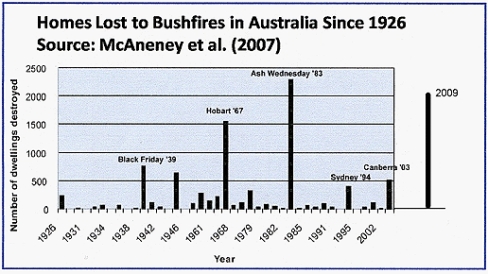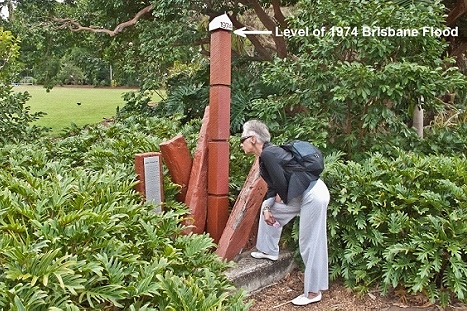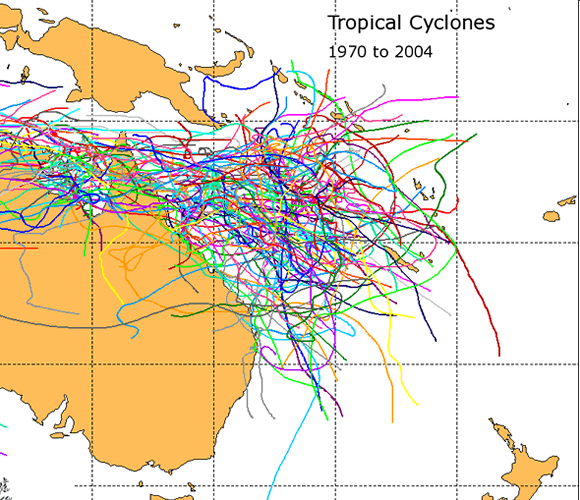For their propaganda, global warming alarmists rely heavily on historic amnesia. This can be well illustrated by examples from Australia.
A large part of Australia has harsh climatic conditions. About 80% of Australia, mostly in the centre of the continent, has an arid to semi-arid climate. Other parts repeatedly suffer from severe droughts or floods.Tropical cyclones regularly strike the northern and northeastern coasts. Most of these weather phenomena are caused by naturally-occurring ENSO (El Niño Southern Oscillation) climatic events.
Indigenous plants and animals have adapted to these severe conditions. The ability of Australian plants to handle fires is quite unique. Eucalypts, the largest tree family in Australia with more than 900 species, have adapted to all climate conditions, from hot arid regions to cold snowfields. They contain inflammable oils that make them susceptible to fires, and many species rely on fire for their seeds to germinate. Another adaptive example is the Paperbark (Melaleuca rhaphiophylla), which has little dormant buds under thick bark. These buds can only sprout when subjected to heat by fire. The bark protects the buds against fire and also provides starch to feed the sprouting buds until they have developed enough green leaves to start photosynthesising. Such trees are therefore called “sprouters”. Paperbarks are also deep-rooted (up to 15 metres) to reach groundwater below scorched surface soil.
Marsupials were the first mammals to develop in Gondwana, of which Australia formed a part. Australia started to drift away from the supercontinent about 55 million years ago, before the placental mammals started to evolve. Marsupials have a slower lifestyle and require less food and water than other mammals. But they have also developed other survival strategies. For instance, during extreme dry conditions, kangaroos can keep embryos in suspended animation until rain arrives. The Thorny Devil lizard (Moloch horridus) collects dew during the night on large spines, which then flows between its scales to its mouth.
These adaptations to harsh climatic conditions, especially heat and drought, must have taken millions of years to evolve. This inescapably means that severe climatic events have been a common natural occurrence in Australia in the past, as they are today. However, this doesn’t seem to deter climate alarmists from blaming every severe drought or flood on human CO2 emissions. Good examples include the 2010 bushfires in Victoria, the recent catastrophic floods in Queensland and the destructive cyclone Yasi.
Bushfires
In February 2009, Victoria was ravaged by catastrophic bushfires. Over 400,000 hectares of vegetation were burnt down, 78 townships were affected, 2029 properties were destroyed, and 173 lives were lost. Bob Brown, the leader of the Greens party, blamed man-made global warming for the disaster. He told Sky News, among others, that
Global warming is predicted to make this sort of event happen 25 percent, 50 percent more.
…
It’s a sobering reminder of the need for this nation and the whole world to act and put at a priority our need to tackle climate change.
Not to be outdone, another well-known Australian climate alarmist, meteorology professor David Karoly, wrote a posting on the bushfires on the Hockey Team blog RealClimate, titled Bushfires and extreme heat in south-east Australia (16 February 2009). Admittedly, he mentions earlier disastrous fires, such as 1939’s Black Friday and 1983’s Ash Wednesday fires, and puts in several caveats, but the general tenure of the article is that man-made global warming was an important contributor. Discussing maximum temperatures Karoly wrote:
Increases of mean temperature and mean maximum temperature in Australia have been attributed to anthropogenic climate change, as reported in the IPCC Fourth Assessment … Hence, anthropogenic climate change is likely an important contributing factor in the unprecedented maximum temperatures on 7 February 2009.
Discussing relative humidity he wrote:
No specific studies have attributed reduced relative humidity to anthropogenic climate change, but it is consistent with increased temperatures and reduced rainfall, expected due to climate change in southern Australia.
It is funny, if it would not be so sad, that his expected “reduced rainfall” was negated by Mother Nature during the severe flooding in January 2011 (see below).
Further on Karoly wrote:
Although formal attribution studies quantifying the influence of climate on the increased likelihood of extreme fire danger in south-east Australia have not yet been undertaken, it is very likely that there has been such an influence. Long-term increases in maximum temperature have been attributed to anthropogenic climate change. In addition, reduced rainfall and lower relative humidity are expected in southern Australia due to climate change.
His final conclusion was that:
it is clear that climate change is increasing the likelihood of environmental conditions associated with extreme fire danger in south-east Australia and a number of other parts of the world.

Figure 1. Graph of lost homes in bushfires since 1926. More homes were lost in 1983 than in 2009.
Figure 1 shows the number of houses lost in bushfires since 1926. The plot is slightly biased, as over time more houses are being built, many in attractive rural forested areas. Notwithstanding this, more houses were lost in the Ash Wednesday fires of 1983 than in the 2009 fire. Historic records going back to the nineteenth century reveal equal or worse bushfires in the past. One of the worst was the Black Thursday fire of 1851, when fires covered a quarter of what is now Victoria (about 5 million hectares), 12 lives were lost and a million sheep and thousands of cattle perished. Other large historic fires occurred in 1898, 1905, 1906, 1912, 1914, and 1919. Nothing to do with man-made global warming.
Floods
In January 2011, Queensland was hit by severe and catastrophic flooding. The worst hit was Toowoomba, west of Brisbane. A wall of water swept like a tsunami through the township. Cars and houses were swept along in the flood. 12 people perished. The flood moved on through the Brisbane River to Brisbane, where large parts of the city were inundated. Boardwalks and other structures along the river banks were swept away. It was the worst flood since 1974, when large parts of the city were also devastated.

Figure 2. Commemorative marker indicating the level of the 1974 Flood in Brisbane’s Botanic Gardens. (Photo Gerrit van der Lingen, 2010)
After the 1974 flood, the Wivenhoe dam was built upstream to help prevent future flooding of Brisbane. However, although this dam’s storage helped mitigate the recent flood slightly, it was not sufficient. The lake behind the dam quickly filled up and water had to be spilled, adding to the flood (incidentally, environmentalists had opposed the building of the dam). Immediately, discussions started about the causes of the flood. Some scientists commented that it was likely that climate change had intensified the monsoon rains that caused the flood. However, some said that although it was predicted that a warmer world would lead to more intense droughts and floods, it wasn’t yet possible to say if climate change would trigger stronger La Niña and El Niño weather patterns that can cause weather chaos across the globe.
Most scientists are agreed that a very strong La Niña caused the recent very heavy rains. David Jones from the Australian Bureau of Meteorology commented that La Niñas and El Niños are now happening in a hotter world. The Hockey Team member Kevin Trenberth from the US added his two pence worth to the debate by saying that higher ocean temperatures around northern Australia could be attributed to global warming. David Karoly again joined the alarmists’chorus, blaming the strong La Niña on record high sea surface temperatures, caused by man-made global warming.
The worst comment came again from Bob Brown, the leader of the Greens party. He blamed the coal industry for the flood. He said that “Coal barons should help pay for the catastrophes”. He argued for an increased tax on the coal industry to “help pay the cost of the predicted more severe and more frequent floods, droughts and bushfires in the coming decades”.
Gerard Henderson, executive director of the Sydney Institute, correctly commented that these eco doomsayers are blind to history. He wrote:
If Brown studied history he would know that there were numerous floods in Brisbane in the 1880s – in 1880, 1893, 1896 and 1898. 1893 was the worst year, with the height of the flood measured at more than nine metres.
El Niños and La Niñas are natural phenomena. Climate alarmists cannot deny this, but they try to convince the public that man-made global warming is causing these phenomena to be stronger and more frequent. However, there is no evidence that this is the case. But hey, why let facts spoil a good story?
The major reason why Brisbane has been hit time and time again by floods is that it is built on the floodplain of the Brisbane River.
Cyclones
As if the destructive Queensland floods were not bad enough, a month later the state was hit by the category 5 Cyclone Yasi. It made landfall south of Cairns. It caused widespread devastation. Houses lost their roof or were flattened. Banana and sugar cane plantations were destroyed. Yachts and boats in marinas were thrown onto the land as match picks. Wind speeds reached 290 km/hr. Some papers reported that this was the strongest cyclone in history, while others wrote that it was the strongest in a hundred years. It seems likely that the very strong La Niña was again to blame. But that did not stop the usual warming alarmists from blaming it on man-made global warming. They compared it with Hurricane Katrina in New Orleans, which they also blame on global warming.The deputy leader of the Australian Greens party, Christine Milne, called cyclone Yasi “a tragedy, but it is a tragedy of climate change”, and said that it is another example why it is important to cut carbon pollution.
Historic amnesia again. Queensland has a long history of tropical cyclones. Australia’s deadliest cyclone occurred more than one hundred years, in March 1899. 307 people perished. This was well before man-made global warming could be blamed.
The Australian Bureau of Meteorology has published an excellent report on the history and causes of Australian tropical cyclones.

Figure 3. Eastern Australian cyclone tracks, from 1970 to 2004. Source: Australian Bureau of Meteorology.
On average 4.7 tropical cyclones per year affect the area of responsibility of the Queensland Tropical Cyclone Warning Centre. They mention a strong oscillating relationship with El Niños and La Niñas, with almost twice as many impacts during a La Niña as during an El Niño episode.
Since 1858 there have been 207 tropical cyclones along the Queensland east coast, the largest including 1890 Cardwell; 1893 Brisbane; 1898 NSW; 1899 Bathurst Bay; 1918 Innisfail; 1918 Mackay; 1927 Cairns and inland areas; 1934 Port Douglas; 1949 Rockhampton; 1954 Gold Coast; 1967 Dinah, Southern Queensland; 1970 Ada, Whitsunday Islands; 1971 Althea, Townsville; 1974 Wanda, Brisbane; and 2006 Larry, Innisfail.
Global warming alarmists are living in their own virtual world, oblivious (often intentionally so) of history and of real world data.
 Sign In
Sign In 0 Items (
0 Items ( Search
Search








